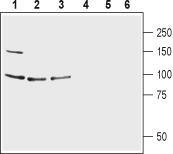Grid1 Rabbit Polyclonal Antibody
CAT#: TA328845
Rabbit Polyclonal Anti-Glutamate Receptor delta1 (GluD1) (extracellular)
Frequently bought together (1)
beta Actin Mouse Monoclonal Antibody, Clone OTI1, Loading Control
USD 200.00
Other products for "Grid1"
Specifications
| Product Data | |
| Applications | IF, IHC, WB |
| Recommended Dilution | WB: 1:200-1:2000; IHC: 1:100-1:3000 |
| Reactivities | Human, Mouse, Rat |
| Host | Rabbit |
| Clonality | Polyclonal |
| Immunogen | Peptide (C)KDMRKLATWDSEK, corresponding to amino acid residues 407-419 of rat GluD1. Extracellular, N-terminus. |
| Formulation | Lyophilized. Concentration before lyophilization ~0.8mg/ml (lot dependent, please refer to CoA along with shipment for actual concentration). Buffer before lyophilization: phosphate buffered saline (PBS), pH 7.4, 1% BSA, 0.05% NaN3. |
| Reconstitution Method | Add 50 ul double distilled water (DDW) to the lyophilized powder. |
| Purification | Affinity purified on immobilized antigen. |
| Conjugation | Unconjugated |
| Storage | Store at -20°C as received. |
| Stability | Stable for 12 months from date of receipt. |
| Gene Name | glutamate ionotropic receptor delta type subunit 1 |
| Database Link | |
| Background | Excitatory neurotransmission in the vertebrate central nervous system is mainly mediated by ionotropic glutamate receptors (iGluRs). Molecular cloning identified 18 mammalian iGluR subunits, of which only 16 sort into the traditional pharmacological subfamilies of AMPA, kainate (KA), and N-methyl-D-aspartate (NMDA) receptors. The 2 remaining subunits were termed â??orphanâ?? receptors, â??glutamate-likeâ?? receptors, â??nonionotropicâ?? receptors, or, most commonly, delta receptors.Ionotropic glutamate receptors are integral membrane proteins composed of four large subunits that form a central ion channel pore. Sequence similarity among all known glutamate receptor subunits, including the d receptors, suggests they share a similar architecture. Glutamate receptor subunits are modular structures that contain four discrete semiautonomous domains: the extracellular amino-terminal domain (ATD), the extracellular ligand-binding domain (LBD), the transmembrane domain (TMD), and an intracellular carboxyl-terminal domain (CTD). The delta family of ionotropic glutamate receptors (iGluRs) consists of the glutamate d1 (GluD1) and glutamate d2 (GluD2) receptors. GluD1 is highly expressed in the inner hair cells of the organ of Corti, diffusely expressed throughout the forebrain during development with high levels in the hippocampus during adulthood. Deletion of GluD1 leads to a deficit in high frequency hearing in mice5. Genetic association studies have established the GRID1 gene, which codes for GluD1, is a strong candidate gene for schizophrenia, bipolar disorder, and major depressive disorder6. Copy number variation studies have also implicated GRID1 in autism spectrum disorder (ASD). In addition, GRID1 gene is localized to the 10q22â??q23 genomic region which is a site for recurrent deletions associated with cognitive and behavioral abnormalities. |
| Synonyms | GluD1; KIAA1220; OTTHUMP00000059648 |
| Note | This antibody was tested in live cell imaging. Please see IF/ICC data for detail. |
| Reference Data | |
Documents
| Product Manuals |
| FAQs |
| SDS |
{0} Product Review(s)
0 Product Review(s)
Submit review
Be the first one to submit a review
Product Citations
*Delivery time may vary from web posted schedule. Occasional delays may occur due to unforeseen
complexities in the preparation of your product. International customers may expect an additional 1-2 weeks
in shipping.






























































































































































































































































 Germany
Germany
 Japan
Japan
 United Kingdom
United Kingdom
 China
China





